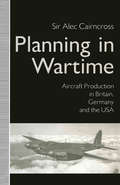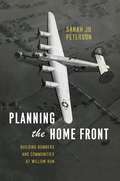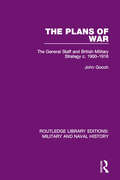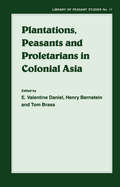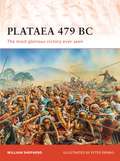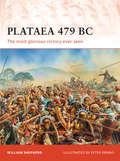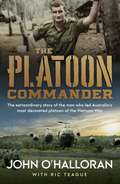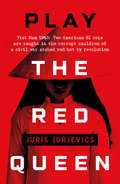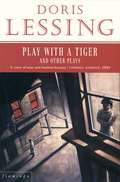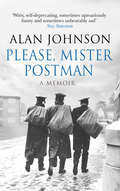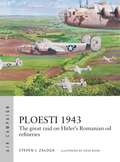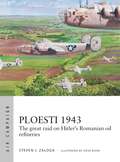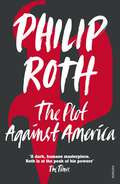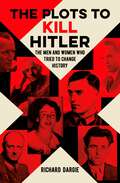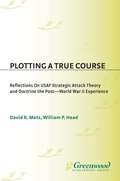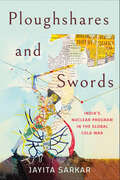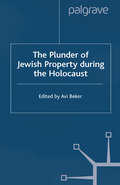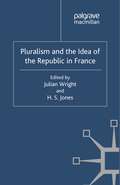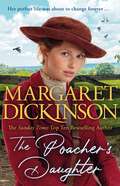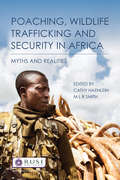- Table View
- List View
Planning in Wartime: Aircraft Production in Britain, Germany and the USA (St Antony's Ser.)
by Sir Alec CairnCrossThe first study of the British Ministry of Aircraft Production, this book examines the war-time policy and operation of the planning department. Topics covered include the organization of the department, production planning and specific programmes.
Planning the Home Front: Building Bombers and Communities at Willow Run (Historical Studies of Urban America)
by Sarah Jo PetersonBefore Franklin Roosevelt declared December 7 to be a “date which will live in infamy”; before American soldiers landed on D-Day; before the B-17s, B-24s, and B-29s roared over Europe and Asia, there was Willow Run. Located twenty-five miles west of Detroit, the bomber plant at Willow Run and the community that grew up around it attracted tens of thousands of workers from across the United States during World War II. Together, they helped build the nation’s “Arsenal of Democracy,” but Willow Run also became the site of repeated political conflicts over how to build suburbia while mobilizing for total war. In Planning the Home Front, Sarah Jo Peterson offers readers a portrait of the American people—industrialists and labor leaders, federal officials and municipal leaders, social reformers, industrial workers, and their families—that lays bare the foundations of community, the high costs of racism, and the tangled process of negotiation between New Deal visionaries and wartime planners. By tying the history of suburbanization to that of the home front, Peterson uncovers how the United States planned and built industrial regions in the pursuit of war, setting the stage for the suburban explosion that would change the American landscape when the war was won.
Planning the Home Front: Building Bombers and Communities at Willow Run (Historical Studies of Urban America)
by Sarah Jo PetersonBefore Franklin Roosevelt declared December 7 to be a “date which will live in infamy”; before American soldiers landed on D-Day; before the B-17s, B-24s, and B-29s roared over Europe and Asia, there was Willow Run. Located twenty-five miles west of Detroit, the bomber plant at Willow Run and the community that grew up around it attracted tens of thousands of workers from across the United States during World War II. Together, they helped build the nation’s “Arsenal of Democracy,” but Willow Run also became the site of repeated political conflicts over how to build suburbia while mobilizing for total war. In Planning the Home Front, Sarah Jo Peterson offers readers a portrait of the American people—industrialists and labor leaders, federal officials and municipal leaders, social reformers, industrial workers, and their families—that lays bare the foundations of community, the high costs of racism, and the tangled process of negotiation between New Deal visionaries and wartime planners. By tying the history of suburbanization to that of the home front, Peterson uncovers how the United States planned and built industrial regions in the pursuit of war, setting the stage for the suburban explosion that would change the American landscape when the war was won.
Planning the Home Front: Building Bombers and Communities at Willow Run (Historical Studies of Urban America)
by Sarah Jo PetersonBefore Franklin Roosevelt declared December 7 to be a “date which will live in infamy”; before American soldiers landed on D-Day; before the B-17s, B-24s, and B-29s roared over Europe and Asia, there was Willow Run. Located twenty-five miles west of Detroit, the bomber plant at Willow Run and the community that grew up around it attracted tens of thousands of workers from across the United States during World War II. Together, they helped build the nation’s “Arsenal of Democracy,” but Willow Run also became the site of repeated political conflicts over how to build suburbia while mobilizing for total war. In Planning the Home Front, Sarah Jo Peterson offers readers a portrait of the American people—industrialists and labor leaders, federal officials and municipal leaders, social reformers, industrial workers, and their families—that lays bare the foundations of community, the high costs of racism, and the tangled process of negotiation between New Deal visionaries and wartime planners. By tying the history of suburbanization to that of the home front, Peterson uncovers how the United States planned and built industrial regions in the pursuit of war, setting the stage for the suburban explosion that would change the American landscape when the war was won.
Planning the Home Front: Building Bombers and Communities at Willow Run (Historical Studies of Urban America)
by Sarah Jo PetersonBefore Franklin Roosevelt declared December 7 to be a “date which will live in infamy”; before American soldiers landed on D-Day; before the B-17s, B-24s, and B-29s roared over Europe and Asia, there was Willow Run. Located twenty-five miles west of Detroit, the bomber plant at Willow Run and the community that grew up around it attracted tens of thousands of workers from across the United States during World War II. Together, they helped build the nation’s “Arsenal of Democracy,” but Willow Run also became the site of repeated political conflicts over how to build suburbia while mobilizing for total war. In Planning the Home Front, Sarah Jo Peterson offers readers a portrait of the American people—industrialists and labor leaders, federal officials and municipal leaders, social reformers, industrial workers, and their families—that lays bare the foundations of community, the high costs of racism, and the tangled process of negotiation between New Deal visionaries and wartime planners. By tying the history of suburbanization to that of the home front, Peterson uncovers how the United States planned and built industrial regions in the pursuit of war, setting the stage for the suburban explosion that would change the American landscape when the war was won.
The Plans of War: The General Staff and British Military Strategy c. 1900-1916 (Routledge Library Editions: Military and Naval History)
by John GoochThis book’s contribution to the discussion on the origin’s of the First World War is a pioneering study of both the British General Staff and the evolution of military strategy in the period immediately prior to the war. It describes the development of the General Staff, Britain’s agency for strategic planning, and goes on to give an account of its role in devising strategy. Problems are examined as they arose at grass-roots level in the War Office and progressed upward towards the Cabinet. The complex cross-currents involving the Admiralty, Foreign Office, Treasury and individuals from Edward VII downwards are charted. The account covers British military policy up to 1916, interpreting the Gallipoli campaign and explanation for its failure.
The Plans of War: The General Staff and British Military Strategy c. 1900-1916 (Routledge Library Editions: Military and Naval History)
by John GoochThis book’s contribution to the discussion on the origin’s of the First World War is a pioneering study of both the British General Staff and the evolution of military strategy in the period immediately prior to the war. It describes the development of the General Staff, Britain’s agency for strategic planning, and goes on to give an account of its role in devising strategy. Problems are examined as they arose at grass-roots level in the War Office and progressed upward towards the Cabinet. The complex cross-currents involving the Admiralty, Foreign Office, Treasury and individuals from Edward VII downwards are charted. The account covers British military policy up to 1916, interpreting the Gallipoli campaign and explanation for its failure.
Plantations, Proletarians and Peasants in Colonial Asia
by Henry Berstein Tom Brass E. Valentine DanielThis volume originated in a conference on 'Capitalist Plantations in Colonial Asia', held at the Centre for Asian Studies of the University of Amsterdam and Free University of Amsterdam in September 1990. The contributions to this collection focus on the production of rubber, sugar, tea, and several less strategic plantation crops, in colonial Indochina, Java, Malaya, the Philippines, India, Ceylon, Mauritius and Fiji (although geographically anomalous, both the latter are included because of the centrality to their sugar plantations of indentured labour from India).
Plantations, Proletarians and Peasants in Colonial Asia
by E. Valentine Daniel Henry Bernstein Tom BrassThis volume originated in a conference on 'Capitalist Plantations in Colonial Asia', held at the Centre for Asian Studies of the University of Amsterdam and Free University of Amsterdam in September 1990. The contributions to this collection focus on the production of rubber, sugar, tea, and several less strategic plantation crops, in colonial Indochina, Java, Malaya, the Philippines, India, Ceylon, Mauritius and Fiji (although geographically anomalous, both the latter are included because of the centrality to their sugar plantations of indentured labour from India).
Plataea 479 BC: The most glorious victory ever seen (Campaign #239)
by Peter Dennis William ShepherdPlataea was one of the biggest and most important land battles of pre-20th century history. Close to 100,000 hoplite and light-armed Greeks took on an even larger barbarian army that included elite Asian cavalry and infantry, and troops from as far away as India, with thousands of Greek hoplites and cavalry also fighting on the Persian side. At points in the several days of combat, the Persians with their greater mobility and more fluid, missile tactics came close to breaking the Greek defensive line and succeeded in cutting off their supplies. But, in a fatal gamble when he nearly had the battle won, their general Mardonius committed the cream of his infantry to close-quarters combat with the Spartans and their Peloponnesian allies. The detailed reconstruction of this complex battle draws on recent studies of early 5th-century hoplite warfare and a fresh reading of the ancient textual sources, predominantly Herodotus, and close inspection of the battlefield.
Plataea 479 BC: The most glorious victory ever seen (Campaign #239)
by Peter Dennis William ShepherdPlataea was one of the biggest and most important land battles of pre-20th century history. Close to 100,000 hoplite and light-armed Greeks took on an even larger barbarian army that included elite Asian cavalry and infantry, and troops from as far away as India, with thousands of Greek hoplites and cavalry also fighting on the Persian side. At points in the several days of combat, the Persians with their greater mobility and more fluid, missile tactics came close to breaking the Greek defensive line and succeeded in cutting off their supplies. But, in a fatal gamble when he nearly had the battle won, their general Mardonius committed the cream of his infantry to close-quarters combat with the Spartans and their Peloponnesian allies. The detailed reconstruction of this complex battle draws on recent studies of early 5th-century hoplite warfare and a fresh reading of the ancient textual sources, predominantly Herodotus, and close inspection of the battlefield.
The Platoon Commander
by John O’Halloran Ric TeagueJohn O'Halloran was a country boy from Tamworth, NSW, who was called up for national service not long after the start of the Vietnam War. As a tough and determined 21-year-old, he guided 6 RAR's B Company 5 Platoon through some of the biggest conflicts of the war, including Operation Hobart and the Battle of Long Tan. But he faced his hardest military challenge at Operation Bribie, leading a fixed bayonet charge against a deadly Viet Cong jungle stronghold.The Platoon Commander is an unmissable and devastating first-hand account of the realities and brutalities of war, and especially this war fought in jungles, not trenches, which would go on to bitterly divide Australians. O'Halloran's sense of duty and strong character carried him and his men through fierce battles and uncertainty. His sense of humour kept him going through the years afterwards. His indomitable spirit inspired the men of 5 Platoon to fight against the odds to achieve the mission - no matter how treacherous - and even away from the action and in the many years since O'Halloran kept the respect of his men.Now regarded by many of his peers as a national treasure, John Patrick Joseph O'Halloran has been quoted in almost every important book written about Australia's involvement in the Vietnam War, yet has never told his own remarkable story. Until now.
Play the Red Queen
by Juris JurjevicsVietnam, 1963. A female Viet Cong assassin is trawling the boulevards of Saigon, catching US Army officers off-guard with a single pistol shot, then riding off on the back of a scooter. Although the US military is not officially in combat, sixteen thousand American servicemen are stationed in Vietnam 'advising' the military and government. Among them are Ellsworth Miser and Clovis Robeson, two army investigators who have been tasked with tracking down the daring killer.Set in the besieged capital of a new nation on the eve of the coup that would bring down the Diem regime and launch the Americans into the Vietnam War, Play the Red Queen is a tour-de-force mystery-cum-social history, breathtakingly atmospheric and heartbreakingly alive with the laws and lawlessness of war.'Steamy and atmospheric... a great gift of a novel' - Dan Fesperman, author of Safe Houses'Jurjevics brings the heat, the smells and the corruption vividly to life... masterfully pulled together'- Sara Paretsky, author of Dead Land'Juris Jurjevics has brilliantly accomplished the seamless combining of a genre form with the deep resonance of literary art' - Robert Olen Butler, Pulitzer Prize winning author of A Good Scent from a Strange Mountain
Play With a Tiger and Other Plays
by Doris LessingThree acclaimed works for the stage by Doris Lessing, winner of the Nobel Prize for Literature
Please, Mister Postman
by Alan JohnsonIn July 1969, while the Rolling Stones played a free concert in Hyde Park, Alan Johnson and his young family left West London to start a new life. The Britwell Estate in Slough, apparently notorious among the locals, in fact came as a blessed relief after the tensions of Notting Hill, and the local community welcomed them with open arms.Alan had become a postman the previous year, and in order to support his growing family took on every bit of overtime he could, often working twelve-hour shifts six days a week. It was hard work, but not without its compensations – the crafty fag snatched in a country lane, the farmer’s wife offering a hearty breakfast and even the mysterious lady on Glebe Road who appeared daily, topless, at her window as the postman passed by…Please, Mister Postman paints a vivid picture of England in the 1970s, where no celebration was complete without a Party Seven of Watney’s Red Barrel, smoking was the norm rather than the exception, and Sunday lunchtime was about beer, bingo and cribbage. But as Alan’s life appears to be settling down and his career in the Union of Postal Workers begins to take off, his close-knit family is struck once again by tragedy…Moving, hilarious and unforgettable, Please, Mister Postman is another astonishing book from the award-winning author of This Boy.
Ploesti 1943: The great raid on Hitler's Romanian oil refineries (Air Campaign)
by Steven J. ZalogaOperation Tidal Wave was one of the boldest and most controversial air raids by the United States Army Air Forces (USAAF). At the time, the Romanian Ploesti oil fields produced about a third of all Axis oil, and was Germany's single most important fuel source. In the summer of 1943, the USAAF decided to stage a major raid on Ploesti from air bases in Libya. The resulting Operation Tidal Wave raid on 1 August 1943 was one of the costliest to date, losing 53 aircraft, about a third of the starting force. Of the more than 150 bombers that took part in the raid, only 88 B-24s returned to Libya, 55 of which were damaged. On the other hand, of the 17 Medals of Honor awarded to US soldiers and airmen from Pearl Harbor in 1941 to D-Day in 1944, 5 were awarded to pilots of the Tidal Wave mission in recognition of their extraordinary performance. Although undoubtedly bold and heroic, the mission had questionable results. Initial assessments argued that the mission caused 40% of the refinery capacity at Ploesti to be lost but subsequent studies concluded that the damage was quickly repaired and that output had exceeded August levels within a month.This new study examines the raid in detail, exploring the reasons why its dubious success came at such a high price. Supported by maps, diagrams, and full-colour artwork including battlescenes and bird's-eye views, this is the full story of the audacious Ploesti raid of 1943.
Ploesti 1943: The great raid on Hitler's Romanian oil refineries (Air Campaign #12)
by Steven J. ZalogaOperation Tidal Wave was one of the boldest and most controversial air raids by the United States Army Air Forces (USAAF). At the time, the Romanian Ploesti oil fields produced about a third of all Axis oil, and was Germany's single most important fuel source. In the summer of 1943, the USAAF decided to stage a major raid on Ploesti from air bases in Libya. The resulting Operation Tidal Wave raid on 1 August 1943 was one of the costliest to date, losing 53 aircraft, about a third of the starting force. Of the more than 150 bombers that took part in the raid, only 88 B-24s returned to Libya, 55 of which were damaged. On the other hand, of the 17 Medals of Honor awarded to US soldiers and airmen from Pearl Harbor in 1941 to D-Day in 1944, 5 were awarded to pilots of the Tidal Wave mission in recognition of their extraordinary performance. Although undoubtedly bold and heroic, the mission had questionable results. Initial assessments argued that the mission caused 40% of the refinery capacity at Ploesti to be lost but subsequent studies concluded that the damage was quickly repaired and that output had exceeded August levels within a month.This new study examines the raid in detail, exploring the reasons why its dubious success came at such a high price. Supported by maps, diagrams, and full-colour artwork including battlescenes and bird's-eye views, this is the full story of the audacious Ploesti raid of 1943.
The Plot Against America: A Novel (Reading Group Guides)
by Philip Roth‘In The Plot Against America, Roth precisely described the sinister and chilling nightmare in which the United States now finds itself… America has not read enough of Philip Roth’ Bernard-Henri Lévy When the renowned aviation hero and rabid isolationist Charles A. Lindbergh defeats Franklin Roosevelt by a landslide in the 1940 presidential election, fear invades every Jewish household in America. Not only has Lindbergh publicly blamed the Jews for pushing America towards a pointless war with Nazi Germany, but, upon taking office as the 33rd president of the United States, he negotiates a cordial 'understanding' with Adolf Hitler, guaranteeing peaceful relations between the two nations. What then follows is the alternative America of this startling counterfactual novel by Philip Roth, who recounts what it was like for his Newark family during the menacingly anti-Semitic years of the Lindbergh presidency. Jewish families are shaken violently apart, whilst America is oblivious to its own dark metamorphosis.‘Many passages in The Plot Against America echo feelings voiced today by vulnerable Americans – immigrants and minorities as alarmed by Trump’s election as the Jews of Newark are frightened by Lindbergh’s’ New Yorker
The Plots to Kill Hitler: The Men and Women Who Tried to Change History
by Richard DargieFrom 1919 onwards, there were many people who wanted to kill Hitler. But when he became Chancellor of Germany in 1933, the desire became more urgent. After all, what do you do when the leader of your country has destroyed all political freedoms, annexed all power and is leading all of its people towards destruction? This is a story of all the plots against Hitler, of secret meetings in freezing fields, of bombs in briefcases, of conspiracies against the life of the Fuhrer, with a cast-list of soldiers, senior politicians, members of the resistance, schoolteachers, theologians, and even a humble carpenter. In all, there were more than 32 attempts against Adolf Hitler's life and this book documents every doomed effort to dismantle the Nazi machine by striking off its head.
Plotting a True Course: Reflections on USAF Strategic Attack Theory and Doctrine The Post World War II Experience (Non-ser.)
by William P. HeadExamining wars from the allied victory in World War II to the conflict in Viet Nam, and finally to the operations in the Gulf and Kosovo, this book presents a comprehensive look at the evolution of strategic air attack theory and doctrine over the years.
Ploughshares and Swords: India's Nuclear Program in the Global Cold War
by Jayita SarkarIndia's nuclear program is often misunderstood as an inward-looking endeavor of secretive technocrats. In Ploughshares and Swords, Jayita Sarkar challenges this received wisdom, narrating a global story of India's nuclear program during its first forty years. The book foregrounds the program's civilian and military features by probing its close relationship with the space program. Through nuclear and space technologies, India's leaders served the technopolitical aims of economic modernity and the geopolitical goals of deterring adversaries.The politically savvy, transnationally connected scientists and engineers who steered the program obtained technologies, materials, and information through a variety of state and nonstate actors from Europe and North America, including both superpowers. They thus maneuvered around Cold War politics and the choke points of the nonproliferation regime. Hyperdiversification increased choices for the leaders of the nuclear program but reduced democratic accountability at home. The nuclear program became a consensus-enforcing device in the name of the nation.Ploughshares and Swords is a provocative new history with global implications. It shows how geopolitical and technopolitical visions influence decisions about the nation after decolonization.Thanks to generous funding from the Swiss National Science Foundation, the ebook editions of this book are available as Open Access volumes from Cornell Open (cornellopen.org) and other repositories.
The Plunder of Jewish Property during the Holocaust: Confronting European History
by A. BekerMore than fifty years after the Holocaust, European and other countries are confronting newly-emerging memories and guilt-filled ghosts from the past. The campaign for the restitution of Jewish property stolen during the Holocaust touched a raw nerve within European society and, together with the end of the Cold War and generational change, created a need to re-evaluate conventional historical truths. A group of experts joined together to review in this book how the issue was dealt with in different countries and how national myths must be re-examined.
Pluralism and the Idea of the Republic in France
by Julian WrightThe idea of the centralized State has played a powerful role in shaping French republicanism. But for two hundred years, many have tried to find other ways of being French and Republican. These essays challenge the traditional account, bringing together new insights from leading scholars.
The Poacher's Daughter: The Heartwarming Page-turner From One of the UK's Favourite Saga Writers
by Margaret Dickinson‘I’m going to live in that house, Dad. One day I’ll be mistress of Thornsby Manor . . .’It is 1910 in the Lincolnshire Wolds. Young Rosie Waterhouse lives with her father, Sam, well known as the local poacher, in a cottage on the Thornsby estate. The land is owned by William Ramsey, a harsh and heartless man who is determined his only son, Byron, should marry well and produce an heir.Rosie is quick to learn the tricks of her father’s trade and it’s when she’s poaching fish from the estate’s stream that she meets Byron. They continue to meet in secret over the coming months and, as their friendship blossoms, they recognize that, despite their vastly different backgrounds, they are destined to be together. When William learns of their bond, he stops at nothing to ensure that they never meet again.As the years pass and the threat of war becomes a reality, Sam is involved in a tragic incident that will affect both his and Rosie’s lives more than they could ever have imagined. Life will never be the same in Thornsby, but will Rosie find the happiness she yearns for?
Poaching, Wildlife Trafficking and Security in Africa: Myths and Realities (Whitehall Papers)
by Cathy Haenlein M L SmithA worldwide surge in poaching and wildlife trafficking is threatening to decimate endangered species. This crisis also threatens the security of human beings in ways ignored until recently by decision-makers slow to begin to treat what is typically viewed as a ‘conservation issue’ as serious crime. Over the past decade, as the scale and profitability of poaching and wildlife trafficking have grown, politicians, journalists and campaigners throughout the world have begun to take notice – they are offering striking appraisals of the threat posed not only to endangered species but also to human populations. Many of these appraisals, however, are made in the absence of a detailed body of empirical research and analysis to underpin them. The result is the growth of a range of myths and misperceptions around the security threats posed, particularly as they relate to Africa. Poaching, Wildlife Trafficking and Security in Africa examines the most common narratives on poaching, wildlife trafficking and security. It critically analyses the dominant discourses on poaching and wildlife trafficking as threats to human security, as drivers of conflict, as funders of terrorism and as a focus for organised crime. In doing so, it seeks to sort myth from reality, to clarify how poaching and wildlife trafficking, as much cited threats to security, can most accurately be conceived. Such a study is crucial to the efforts of stakeholders now rightly looking to respond not just to the threat posed to endangered species, but also to the security and wellbeing of human beings.
